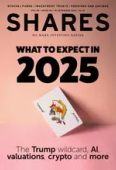Archived article
Please note that tax, investment, pension and ISA rules can change and the information and any views contained in this article may now be inaccurate.
How to invest for children this Christmas

Lots of parents and grandparents default to cash when saving for their children or grandchildren, but most have a very long time until they will give the money to the children, meaning investing can be a great option.
If we look at someone saving £1,000 a year from birth of the child until the age of 18, they’d hand them almost £8,000 more if they invested the money and earned 5% return a year after charges, compared to a hypothetical 2% return from cash. But where should you start?
The tax benefit of gifting
Gifting money is a great way to move the assets out of your estate for inheritance tax purposes. Everyone can pass on an estate worth up to £325,000 free of inheritance tax, and some people are eligible for an additional £175,000 limit if they are passing on their main home. But after that the estate will have to pay 40% tax. If you know you’re going to hit this threshold and can afford to part with money now, moving money out of the estate while you’re alive can save tax in the future.
Anyone can gift up to £3,000 a year, as well as extra amounts when certain people in the family get married, without it being considered for inheritance tax purposes. Any gifts over that amount will be subject to the seven-year rule, which means that if you were to die inheritance tax is due on a sliding scale until seven years have passed.
PICK AN ACCOUNT
When you’re starting out it might feel a bit confusing picking the right account. A Junior ISA is a good option for many: you can pay in up to £9,000 a year, the money is ring-fenced in the child’s name and it’s locked up until they turn 18.
However, if you want a bit more flexibility or think you might want access to the money before your grandchild’s 18th birthday, you could just save the money in your own ISA. It means you’ll have to use up some of your own £20,000 ISA allowance, but that is only an issue if you think you’ll max out that limit for your own savings. The money isn’t ring-fenced and you access it at any time – which is both a pro and a con. If you’re worried you might dip into the money it may be better in a Junior ISA, but if you want the flexibility to access it if you need to, it might be a good option.
Your longer-term option is a pension for your child: a Junior SIPP. You can save up to £2,880 in this account, which will get topped up with tax relief from the government to £3,600. But it’s a very long-term option, as your child won’t be able to access the money until they reach retirement age. However, if you made just one contribution of £2,880 at birth and it grew by 5% a year, your child would have a pot worth £46,500 by the age of 57 – showing the magic of investment growth and compounding.
PICK A WAY TO SAVE
You can choose whether to make a lump sum investment for your grandchild or spread the money throughout the year. You can set up monthly investing for the children in your life and contribute a small amount each month. Many investment platforms will allow you to start regular investing from as little as £25 a month. You can always pause it one month if you need to skip a month, but it means you don’t have to actively log in and invest money every month. If set up from birth, a £25 a month contribution could give them a pot worth £8,800 by the time they are 18 based on them achieving a 5% return.
At the other end of the spectrum, the Junior ISA limit is a whopping £9,000, and any grandparent fortunate enough to be able to put that amount away for their child each Christmas would be handing them a £266,000 present on their 18th birthday, assuming the same 5% investment returns a year. However, for many grandparents that will be a pipe dream and even squirreling away a little money each festive season will be enough to help your grandchild out when they’re 18.
PICKING INVESTMENTS
When it comes to picking investments the first question is whether you want to pick the stocks yourself or outsource that task to a fund. If you opt for funds, you’ll want to weigh up using an active fund manager or a passive fund. There’s no right answer to this, it comes down to preference. Put simply, a passive investment approach will cost you less but will only track the performance of the market – never outperform it. With active management you’re paying more to have a fund manager pick stocks for you, but the hope is that this will generate a higher return.
There’s no need to sit entirely in one camp, you could mix the two approaches. For example, having a broader UK stock market tracker and then using an active fund for a more specialist area. Another option is to pick a multi-asset or ‘all-in-one’ fund, which can be active or passive and invests in a mixture of different assets, meaning you only need invest in one fund that is already diversified, rather than picking lots of different investments.
When investing for your children it’s important to think about the timeframe. If they are young, you could have up to 18 years until they will access the money. This makes for a decent investment horizon and means you could potentially take more risk with the money, as you have time to ride out the ups and downs of the market. Conversely, if your child is closer to 18 you might want to take less risk or even stick to cash.
Three funds for investing for children
Fidelity Index World (BJS8SJ3) – A low-cost passive fund that tracks the global stock market and gives exposure to hundreds of companies around the world. A good option to form a well-diversified core of your portfolio and only costs 0.12% a year.
Liontrust Sustainable Future Global Growth Acc (3003006) – Many grandparents may want to invest in a sustainable fund option for their grandchild’s future. The Liontrust team have been investing in sustainable and responsible funds for a long time and this £1.4bn fund invests in companies around the world that provide or produce sustainable products and services. It costs 0.85% a year.
JP Morgan Emerging Markets Investment Trust (JMG) – For grandparents who have a longer time horizon or want to take more risk, emerging markets could be an option. Run by a fund manager with three decades of experience, this trust invests in around 70 large companies in the emerging markets. It costs 0.79% a year.
Important information:
These articles are provided by Shares magazine which is published by AJ Bell Media, a part of AJ Bell. Shares is not written by AJ Bell.
Shares is provided for your general information and use and is not a personal recommendation to invest. It is not intended to be relied upon by you in making or not making any investment decisions. The investments referred to in these articles will not be suitable for all investors. If in doubt please seek appropriate independent financial advice.
Investors acting on the information in these articles do so at their own risk and AJ Bell Media and its staff do not accept liability for losses suffered by investors as a result of their investment decisions.
Issue contents
Editor's View
Feature
Great Ideas
Money Matters
News
- Can Chemring profit play catch-up after slow start to the year?
- Why Rolex seller Watches of Switzerland has clocked up a 40% gain in six months
- China eases monetary policy ahead of Trump 2.0 and global tariff war
- Budget impact on UK firms tops £1 billion as hiring slows
- Frasers shares down 30% year-to-date as Budget blues bite
 magazine
magazine








